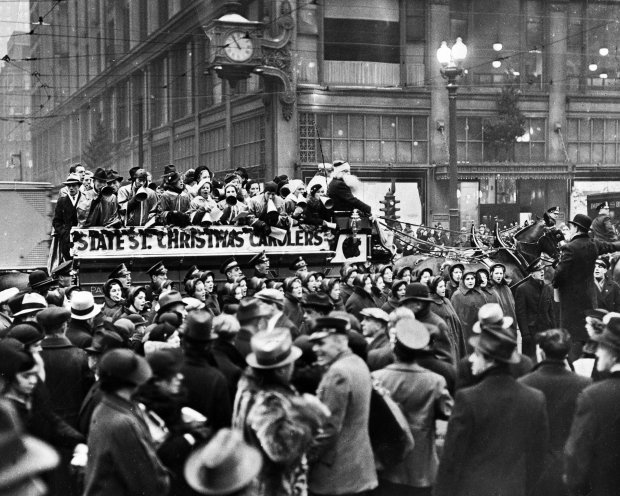Like the story of Rudolph the Red-Nosed Reindeer, Chicago’s Thanksgiving Parade was created for a Scrooge-like reason — to make money.
Ninety years ago, the nation was deep in the Great Depression and the city’s retailers were struggling. That’s why the State Street Council (which has been part of the Chicago Loop Alliance since 2005) decided to raise spirits in a traditional way — with a promenade through the city’s shopping district.
But the parade — which is 10 years younger than its New York City counterpart, the Macy’s Thanksgiving Day Parade — has not always happened in November. With its name, location and sponsors changing several times throughout the decades, the city’s Thanksgiving Parade has sometimes happened closer to Christmas.
One staple since its humble beginnings? Santa Claus. His method of arrival has included a carriage, a Jeep, the subway and even a boat, but the jolly old fellow hasn’t missed a year.
Here’s a look back at milestones of this popular event, which ushers in the holiday season.
Chicago history headlines
- Nov. 21, 1875: Holy Name Cathedral was dedicated.
- Nov. 22, 1987: Viewers watching “Doctor Who” on WTTW-TV experienced one of the oddest things ever to cross Chicago televisions — a 90-second hijacking of the airwaves, featuring a person dressed as Max Headroom.
- Nov. 23, 1912: The Rouse Simmons, known as the “Christmas Tree Ship,” vanished in a storm on Lake Michigan during its trip from Michigan to Chicago. There were no survivors. A diver found the well-preserved remains of the Rouse Simmons in 1971, resting in about 170-foot deep waters northeast of Two Rivers, Wisconsin.
- Nov. 24, 1959: Fourteen people died after a Trans World Airlines freighter crashed in a residential area southwest of Midway while attempting an emergency landing.
- Nov. 25, 1987: Chicago Mayor Harold Washington — who vowed to serve the city in that position for 20 years — was stricken by a heart attack while sitting at his desk just nine months after winning reelection to a second term and with a majority of the city’s 50 aldermen finally working with him. He was pronounced dead at 1:36 p.m.
Dec. 7, 1934
Santa Claus arrived on State Street in a caravan of decorated trucks loaded with fresh items from retailers lining his path.
Though it was the middle of the Great Depression, people were eager to scoop up toys and other gifts for their loved ones. And the sound of registers ringing up the purchases was music to the store owners’ ears.
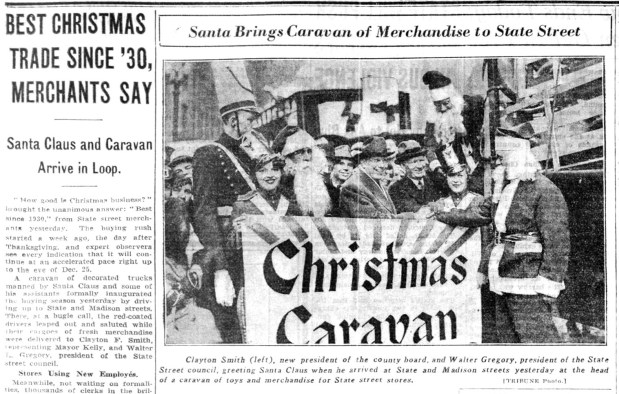
“People are spending more freely than at any time since 1930,” one manager told the Tribune. “They are not only willing, but anxious to buy. Not for three years has there been so much really new and different in the offering of merchandise. In the heart of depression, manufacturers laid off designers, but this has all been changed in the last year. There is better goods for sale and the shoppers are buying it.”
And since the Century of Progress World’s Fair wrapped up just about a month prior, retailers hoped to make the shopping experience its own exciting experience.
Nov. 20, 1943
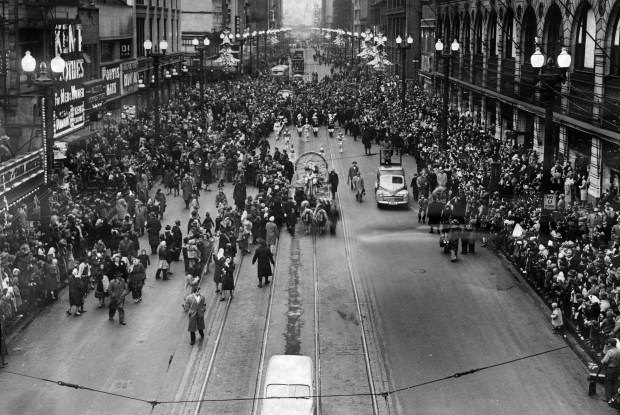
Santa Claus came to town, but not via Dancer, Prancer and his other tiny reindeer — he took “his first ride in Chicago’s subway,” the Tribune reported. It was one of the ways the parade, which continued during World War II, got creative despite limited resources.
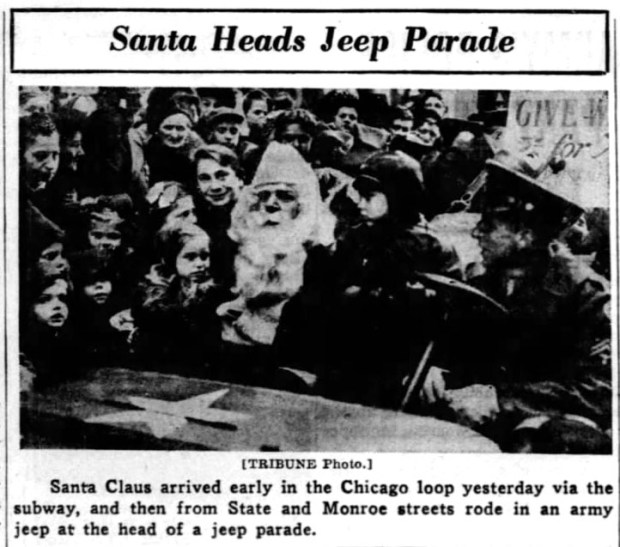
He emerged from the station at State and Monroe streets through a smoke screen and handed out candy bars to children before hopping into a Jeep supplied by the U.S. Army and guided families to the shopping district.
“It’s uncanny!” the manager of an unnamed toy department said. “They’ll buy anything this year! Junk, good stuff — they don’t care. There’s never been another year like it. We did our November business in October, and now we’re doing our usual December business. Heaven help us by Christmas!”
Nov. 18-19, 1949
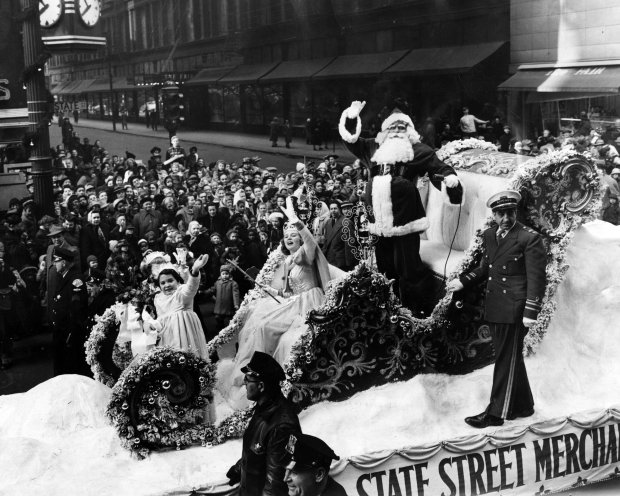
For the first time, Santa Claus had a partner in heralding the Christmas season.
Representing an old legend of light and goodwill, the Star Queen paved the way for the holiday season’s famous visitor. Portraying the Star Queen was 17-year-old Nancy Loving, dressed in a regal blue robe and a glittering crown atop her blonde curls. With a wave of her wand, thousands of twinkling lights sprang to life on State Street, otherwise known as Chicago’s White Way.
The next day, Santa Claus’ elaborately planned entrance — with entertainer Bob Hope, clowns and professional athletes in tow — didn’t quite go smoothly.
“He arrived in Chicago via train, boat and float, and he should have stuck to his good, old-fashioned, faithful reindeer,” the Tribune reported. “The train was late. The boat grounded in the river, and his magnificent float was practically over-run by a half million yelling children and impatient parents in State Street. It took 325 policemen and 275 Andy Frain ushers to keep things in order.”
Still, everyone seemed happy — including Tribune reporter Rita Fitzpatrick.
“It was the finest toyland parade ever seen here,” she wrote. “For one hour, delightful, fantastic and gigantic balloon characters, some measuring 80 feet long and 13 feet tall, bobbed down the street grinning with mischievous charm.”
Nov. 29, 1959

Screams from children gave way to teenagers for singer Fabian, whose bright red convertible was mobbed along the State Street parade route from Wacker Drive to Congress (now Ida B. Wells Drive). Though his coat was torn, no injuries were reported, according to the Tribune.
Though temperatures were in the 20-degree rang and the event was held for the first time on a Sunday, up to half a million people still turned out for the event with thousands more watching it on TV at home. Santa Claus towered above the crowd in a snorkel provided by the Chicago Fire Department.
Nov. 28, 1965
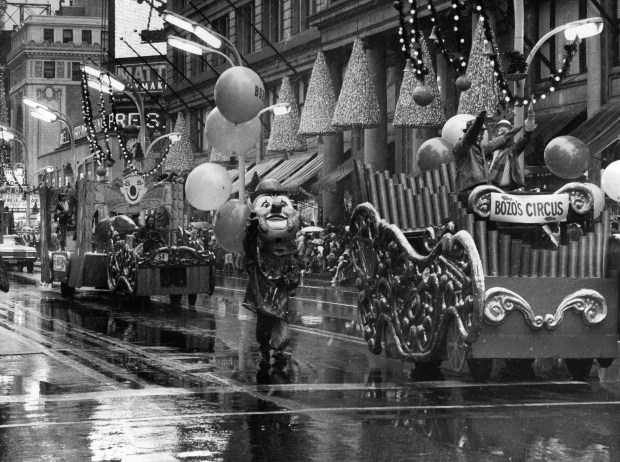
WGN-TV’s Bozo the Clown, high school bands with pompon girls and rock ’n’ roll bands with “go-go girls” entertained the shivering crowd of almost 100,000 people. But an “excited throng of youngsters” gathered around the convertible carrying actor Robert Vaughn, from the TV show “The Man From U.N.C.L.E.”
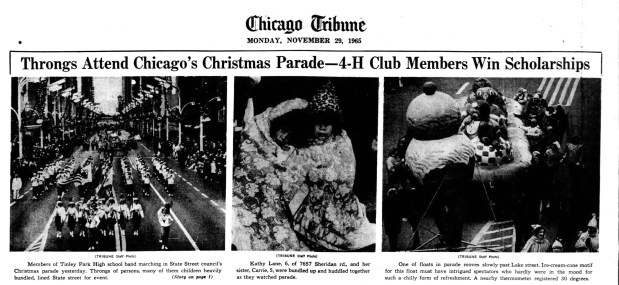
Mayor Richard J. Daley and State Street Council Chairman Otto L. Preisler were driven down the route in a car, which had been used by Pope Paul VI during a recent visit to the United Nations in New York City.
Accompanying the parade’s theme of “Double fun for everyone” were more than 80 sets of twins — ranging in age from 6 to 46.
Nov. 28, 1970

Citing rising costs, the State Street Council refused to foot the bill for the beloved parade for the first time in its existence. The parade still went on, however, thanks to funding provided by Mayor Daley’s Youth Foundation.
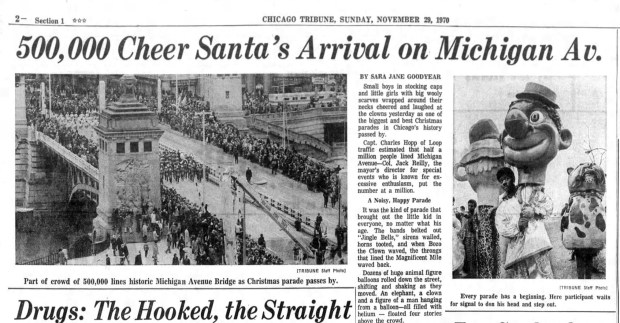
Michigan Avenue became the new route and helium-filled balloons flew four stories above the ground past the city’s historic Water Tower and John Hancock Center.
Nov. 28, 1987
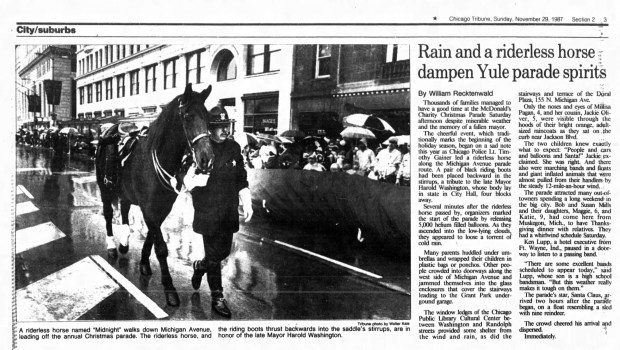
The occasion took on a somber mood as it was led down Michigan Avenue by a riderless horse with black riding boots placed backward in the stirrups. The tribute was in honor of Mayor Harold Washington, whose body lay in state in City Hall just four blocks away. Washington died from a heart attack just three days before the parade.
Nov. 25, 1999

The popular holiday tradition received a new name — the Marshall Field’s Jingle Elf Parade — a new date and a new route. With WLS-Ch. 7 as a new sponsor, the parade stepped off live on TV on Thanksgiving Day from State Street, proceeding south from Randolph Street to Congress (now Ida B. Wells Drive). Between 300,000 and 400,000 people watched the spectacle in person.
Among the event’s 15 helium-filled balloons were a 60-foot-tall Kermit the Frog, Furby and Bear in the Big Blue House. One challenge: Fitting them under the L platform at State and Van Buren streets.
Want more vintage Chicago?
- Become a Tribune subscriber: It’s just $12 for a 1-year digital subscription
- Follow us on Instagram: @vintagetribune
Thanks for reading!
Join our Chicagoland history Facebook group and follow us on Instagram for more from Chicago’s past.
Have an idea for Vintage Chicago Tribune? Share it with Kori Rumore and Marianne Mather at krumore@chicagotribune.com and mmather@chicagotribune.com


